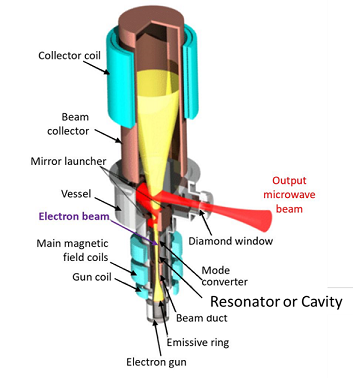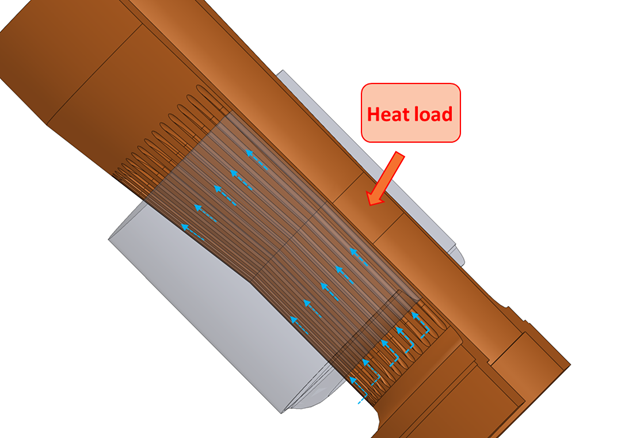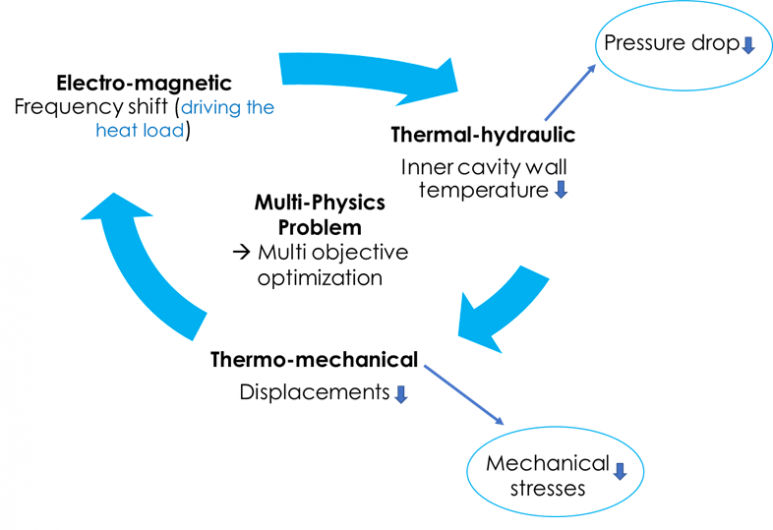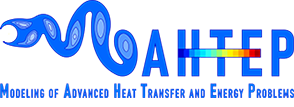Development of a methodology for the shape optimization for gyrotron resonators
Activity carried out by: Rosa Difonzo (tutored by Prof. Laura Savoldi) in collaboration with Prof. Antonio Cammi.
Objective of the activity: Study a technological solution for the Gyrotron cavity cooling and development a robust methodology for multi-objective optimization of coupled thermal-hydraulic and thermo-mechanical problems.
Framework of the activity:
The Electron Cyclotron Resonance Heating (ECRH) is one of the three plasma heating devices used in nuclear fusion machines based on the magnetic confinement of plasma, such as tokamaks and stellarators. The ECRH relies on high power generators operating in the MW range at millimetric wave frequencies for continuous wave pulses, for which the Gyrotron oscillators are widely employed as a consolidated solution. The gyrotron performances depend crucially on the heat sink capability and thermomechanical stability of the resonant cavity (resonator). An efficient cooling allows to select operative modes with high beam/wave interaction efficiency.
In the ITER machine, 24 Gyrotrons at 1 MW-170 GHz with a pulse duration of more than 500 s will be installed. Gyrotrons for ITER’s ECRH are under development in Europe, India, Japan and Russia.
The actual cooling systems of the W7-X Gyrotrons and the ITER European Gyrotrons prototype are based on the Thales-patented Raschig Rings (RR) technology, a well-known solution adopted originally as column packing in distillation and then in packed beds, especially for chemical processes. The RR technology in the cavity resonator has already proven to be capable to manage heat load peaks up to ~ 20 MW/m2, but its suitability to bear the even higher heat fluxes, foreseen for the EU DEMO gyrotron, is under investigation, in view of the uncertainties in its removal capability. In order to improve the heat management of cavities, targeted to the design of higher RF efficiency tubes, several alternative options are being investigated, such as mini-channels (MC) solution, on which several preliminary investigations were already carried out at Politecnico di Torino.
If, on the one hand, the MC option can overcome the RR one in terms of heat removal capability (thermal performance), on the other hand the large flow section available for the coolant in the RR configuration (which is the reason for the above-mentioned low water-flow velocity) potentially ensures, with respect to the MC option, a reduced pressure drop (hydraulic performance).

Figure 1. Sketch of the cross-section of a Gyrotron, based on [1].
Planned activity:

Figure 2. Sketch of the cross-section of the Gyrotron resonant cavity cooled with mini-channels. The blue arrows show the water path along the mini-channels.
The main aim of the research project consists in the design optimization of the mini-channels cooling system of a Gyrotron cavity for nuclear fusion applications. The optimization for this application is multi-objective, since not only displacements are important, reduced by increasing the cooling efficiency, but also mechanical stresses and pressure drops. Because of the very high temperature reached in the cavity structure (180-250 °C) and the complexity of the cooling geometry itself, state-of-the-art analyses performed with the MUCCA code predict, for the current “best” MC configuration, the plasticization of the structure. Plasticization was in fact already observed in some gyrotrons, though equipped with Raschig Rings cooling system, reducing then the potential interest of the MC solution. Considering all the listed variables, the analysis proposed here constitutes a very complicated problem which requires a systematic approach.
First, the target functions and their respective weights and constraints will be clearly identified, also in collaboration with PoliMi, THALES, F4E, EPFL and KIT. Then, to reach the goal of the study, different already existing methodologies will be considered through a multi-step approach.
A comprehensive analysis of the existing topology optimization method will be carried out. Two methods are already candidate to the analysis: shape optimization method, based on the adjoint approach, which is capable of computing the objective function sensitivities with respect to the design variables and the constructal theory, working on minimum entropy system production. Starting form simple, well-known optimization problems, in thermal-hydraulic and thermo-mechanical fields, the efficiency of several optimization methods will be analysed in other to chose the most suitable for the case under study.
After that, a dedicate modelling of the case study of the Gyrotron cavity, starting from the already existing MUCCA tool, will be carried out and the chosen method(s) will be applied to the multi-objective problem under study. For the configuration which gave the best overall performance the corresponding design will be computed with MUCCA and compared with those of the starting configurations.
The final aim is the extension of the adopted methodology to similar problems requiring shape optimization of high heat flux components subjected to simultaneous thermal, mechanical, electrical and geometrical constraints.

Figure 3. Scheme of the multi-objective optimization problem.
References:
[1] Swiss Plasma Center, "Gyrotron", [Online]. Available: https://archive.org/details/gyrotron. [Accessed 5 January 2020]

